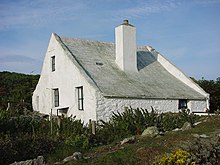Ronald Lockley
While still at school, he spent his weekends and summer holidays living rough in the woods and wetlands that now form the Glamorganshire Canal local nature reserve.
[2] In 1927, with his first wife Doris Shellard, he took a 21-year lease of Skokholm, a small island some 4 kilometres (2.5 mi) off the western tip of Pembrokeshire, which was inhabited only by rabbits and seabirds.
He played a key part in the preliminary survey of the natural history of Skomer Island in 1946,[10] re-establishing Skokholm as a bird observatory and establishing the Council for the Promotion of Field Studies in Dale Fort.
[13] Living at Orielton, a large estate near Pembroke, he undertook a four-year scientific study of rabbit behaviour for the British Nature Conservancy during the 1950s.
[7] His belief that successive British governments were not sufficiently aware of the threat to the landscape from industrial development led to his decision to emigrate to New Zealand in 1970, with his third wife.
Lockley's The Private Life of the Rabbit (1964) played a role in the plot development of his friend Richard Adams's children's book Watership Down.
